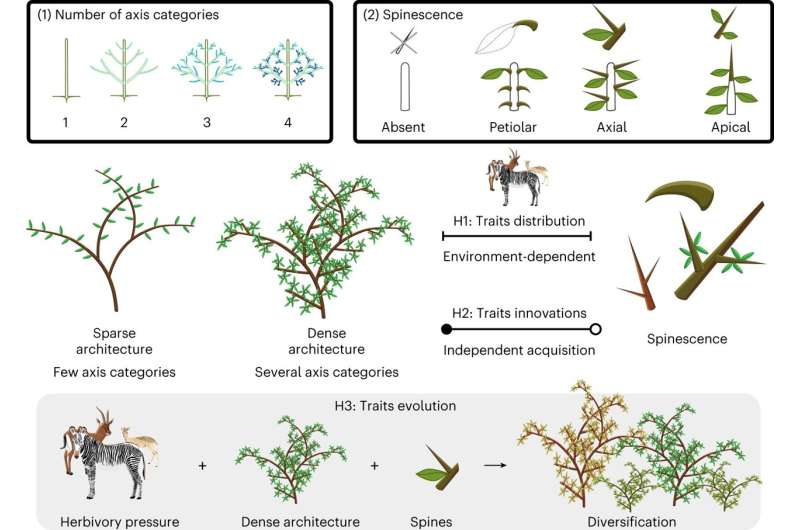This article has been reviewed according to Science X's editorial process and policies. Editors have highlighted the following attributes while ensuring the content's credibility:
fact-checked
trusted source
proofread
Defensive cage architectures in herbivore-driven ecosystems

Dense branching and spines are common features of plant species in ecosystems with high mammalian herbivory pressure. The combination of dense branching and spines is likely to produce the most effective herbivore defenses, as dense branching directly translates into higher spine densities. However, how cage architecture evolved under mammalian pressure has remained unexplored.
In a study published in Nature Plants
, researchers from the Xishuangbanna Tropical Botanical Garden (XTBG) of the Chinese Academy of Sciences and their collaborators analyzed how two traits,
Using a phylogenetic comparative approach, they examined the emergence of dense branching and spines as a two-step evolutionary process for defensive cage structures in mammalian-dominated ecosystems.
The researchers first identified species that evolved in areas of high herbivory pressure based on the abundance of large browsing herbivores and pre-Anthropocene herbivore biomass. They then described branching density and spine presence in 132 Combretaceae species, and compared how these traits were expressed across herbivory regimes and biomes.
The researchers then used biogeographic inference to estimate ancestral herbivory regimes and the timing of trait acquisition, identifying potential congruent events. Finally, they used State-dependent Speciation and Extinction models to assess how dense architectures and spines influenced species evolutionary rates under different herbivory pressures.
The results showed that modern plant architectural strategies evolved through a step-wise process. First, dense branches emerged under moderate herbivory pressure and then spines, which support higher species formation rates were acquired under high herbivory pressure.
"We can say that the combination of dense branches and spines forms a strong defensive cage that is essential for resistance to herbivory by mammals," said Kyle W. Tomlinson of XTBG.
The study highlights the adaptive value of dense branches as part of an herbivore defense strategy and confirms that large mammalian herbivory is the primary selective force shaping the overall plant architecture of woody plants.
More information: Artémis Anest et al, Blocking then stinging as a case of two-step evolution of defensive cage architectures in herbivore-driven ecosystems, Nature Plants (2024). DOI: 10.1038/s41477-024-01649-4
Provided by Chinese Academy of Sciences





















